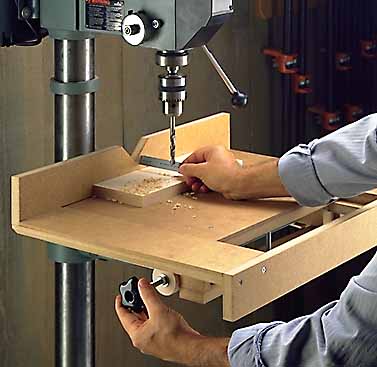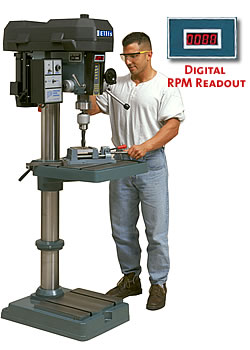Drilling
From DDL Wiki
| Line 1: | Line 1: | ||
Drilling is a subtractive process where a drill and drill bit are used to bore a hole/s through the material being worked on; wood, metal, hard plastics or ceramics are a few examples. | Drilling is a subtractive process where a drill and drill bit are used to bore a hole/s through the material being worked on; wood, metal, hard plastics or ceramics are a few examples. | ||
| - | [[Image:RAAD__drillpress.jpeg]] | + | [[Image:RAAD__drillpress.jpeg]] |
| + | |||
[[Image:RAAD__31.jpeg]] | [[Image:RAAD__31.jpeg]] | ||
| + | Above: Images of Drill Press | ||
A drill is a tool with a rotating drill bit used to bore holes. The twist drill is most common form, and consists of a cylindrical metal rod with two helical flutes or grooves spiralling along its length. Straight flutes are also used. The drill bit is gripped by the chuck of the drill at one end, with the other end pressed against the target material and rotated. The earliest drills were probably bow drills. | A drill is a tool with a rotating drill bit used to bore holes. The twist drill is most common form, and consists of a cylindrical metal rod with two helical flutes or grooves spiralling along its length. Straight flutes are also used. The drill bit is gripped by the chuck of the drill at one end, with the other end pressed against the target material and rotated. The earliest drills were probably bow drills. | ||
Revision as of 11:14, 9 February 2007
Drilling is a subtractive process where a drill and drill bit are used to bore a hole/s through the material being worked on; wood, metal, hard plastics or ceramics are a few examples.
Above: Images of Drill Press
A drill is a tool with a rotating drill bit used to bore holes. The twist drill is most common form, and consists of a cylindrical metal rod with two helical flutes or grooves spiralling along its length. Straight flutes are also used. The drill bit is gripped by the chuck of the drill at one end, with the other end pressed against the target material and rotated. The earliest drills were probably bow drills.
Under normal usage, swarf is carried up and away from the tip of the drill bit by the fluting. The continued production of chips from the cutting edges produces more chips which continue the movement of the chips outwards from the hole. This continues until the chips pack too tightly, either because of deeper than normal holes or insufficient backing off (removing the drill slightly or totally from the hole while drilling). Lubricants and coolants (i.e. cutting fluid) are sometimes used to ease this problem and to prolong the tools life by cooling and lubricating the tip and chip flow. Coolant is introduced via holes through the drill shank (see gun drill bits).
Straight fluting is used for copper or brass, as this exhibits less tendency to "dig in" or grab the material. If a helical drill (twist drill) is used then the same effect can be achieved by stoning a small flat parallel with the axis of the drill bit.
For heavy feeds and comparatively deep holes oil-hole drills can be used, with a lubricant pumped to the drill head through a small hole in the bit and flowing out along the fluting. A conventional drill press arrangement can be used in oil well drilling, but is more commonly seen in automatic drilling machinery in which it is the workpiece that rotates rather than the drill bit.
(Source: http://en.wikipedia.org/wiki/Drilling#Drilling_in_metal)
Posted by: Drew Serdy, Rory Kaclik, Anthony Fazzini, Ali Khan


